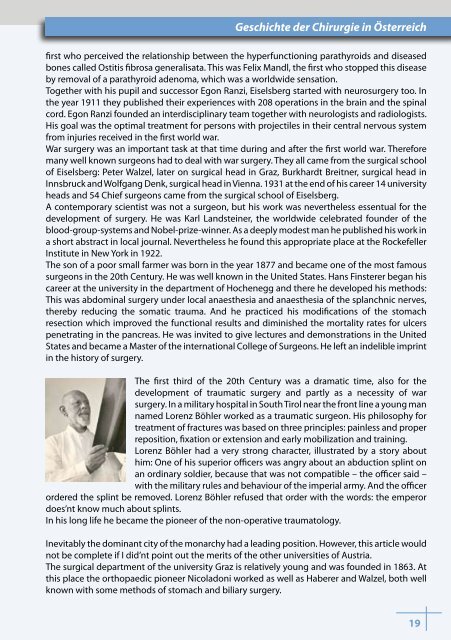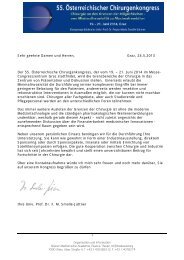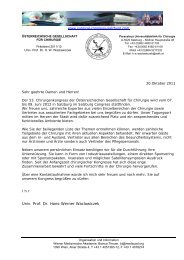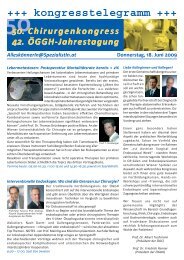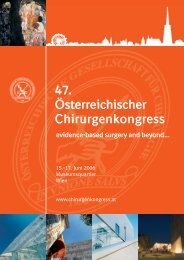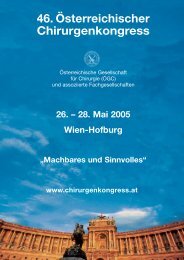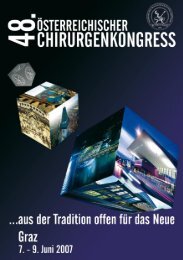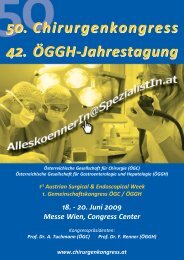3w - 54. Österreichischer Chirurgenkongress
3w - 54. Österreichischer Chirurgenkongress
3w - 54. Österreichischer Chirurgenkongress
Erfolgreiche ePaper selbst erstellen
Machen Sie aus Ihren PDF Publikationen ein blätterbares Flipbook mit unserer einzigartigen Google optimierten e-Paper Software.
Geschichte der Chirurgie in Österreich<br />
first who perceived the relationship between the hyperfunctioning parathyroids and diseased<br />
bones called Ostitis fibrosa generalisata. This was Felix Mandl, the first who stopped this disease<br />
by removal of a parathyroid adenoma, which was a worldwide sensation.<br />
Together with his pupil and successor Egon Ranzi, Eiselsberg started with neurosurgery too. In<br />
the year 1911 they published their experiences with 208 operations in the brain and the spinal<br />
cord. Egon Ranzi founded an interdisciplinary team together with neurologists and radiologists.<br />
His goal was the optimal treatment for persons with projectiles in their central nervous system<br />
from injuries received in the first world war.<br />
War surgery was an important task at that time during and after the first world war. Therefore<br />
many well known surgeons had to deal with war surgery. They all came from the surgical school<br />
of Eiselsberg: Peter Walzel, later on surgical head in Graz, Burkhardt Breitner, surgical head in<br />
Innsbruck and Wolfgang Denk, surgical head in Vienna. 1931 at the end of his career 14 university<br />
heads and 54 Chief surgeons came from the surgical school of Eiselsberg.<br />
A contemporary scientist was not a surgeon, but his work was nevertheless essentual for the<br />
development of surgery. He was Karl Landsteiner, the worldwide celebrated founder of the<br />
blood-group-systems and Nobel-prize-winner. As a deeply modest man he published his work in<br />
a short abstract in local journal. Nevertheless he found this appropriate place at the Rockefeller<br />
Institute in New York in 1922.<br />
The son of a poor small farmer was born in the year 1877 and became one of the most famous<br />
surgeons in the 20th Century. He was well known in the United States. Hans Finsterer began his<br />
career at the university in the department of Hochenegg and there he developed his methods:<br />
This was abdominal surgery under local anaesthesia and anaesthesia of the splanchnic nerves,<br />
thereby reducing the somatic trauma. And he practiced his modifications of the stomach<br />
resection which improved the functional results and diminished the mortality rates for ulcers<br />
penetrating in the pancreas. He was invited to give lectures and demonstrations in the United<br />
States and became a Master of the international College of Surgeons. He left an indelible imprint<br />
in the history of surgery.<br />
The first third of the 20th Century was a dramatic time, also for the<br />
development of traumatic surgery and partly as a necessity of war<br />
surgery. In a military hospital in South Tirol near the front line a young man<br />
named Lorenz Böhler worked as a traumatic surgeon. His philosophy for<br />
treatment of fractures was based on three principles: painless and proper<br />
reposition, fixation or extension and early mobilization and training.<br />
Lorenz Böhler had a very strong character, illustrated by a story about<br />
him: One of his superior officers was angry about an abduction splint on<br />
an ordinary soldier, because that was not compatible – the officer said –<br />
with the military rules and behaviour of the imperial army. And the officer<br />
ordered the splint be removed. Lorenz Böhler refused that order with the words: the emperor<br />
does’nt know much about splints.<br />
In his long life he became the pioneer of the non-operative traumatology.<br />
Inevitably the dominant city of the monarchy had a leading position. However, this article would<br />
not be complete if I did’nt point out the merits of the other universities of Austria.<br />
The surgical department of the university Graz is relatively young and was founded in 1863. At<br />
this place the orthopaedic pioneer Nicoladoni worked as well as Haberer and Walzel, both well<br />
known with some methods of stomach and biliary surgery.<br />
19


